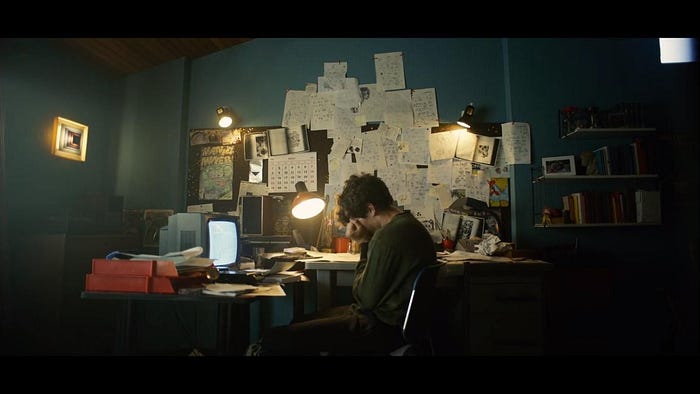The producer of Black Mirror: Bandersnatch reveals the challenges of creating Netflix’s first adult interactive film
You don’t often hear people saying, “which ending did you get?” after watching a film. Black Mirror: Bandersnatch changed that.
Bandersnatch is an interactive film set in 1984 about young videogame programmer Stefan (Fionn Whitehead) who descends into madness as he attempts to adapt a build-your-own-adventure novel into a videogame. If you haven’t seen it yet and want to experience multiple pathways, sitting-on-the-edge-of-your-seat drama and mind-boggling confrontations about free will, be sure to set aside at least five hours of your day to do so. The journey may be long, but I assure you it’ll be a very rewarding (acid) trip.
In the cultural event ‘Interactive Audiences with Black Mirror: Bandersnatch’, presented by the Guild of Media Arts in collaboration with York Mediale, producers Russell McLean and Sharon Reid discussed the future of interactive storytelling. Russel started his career producing music videos for artists such as Snow Patrol, Paul McCartney, and REM. He currently works as a producer for interactive films such as Netflix’s 2018 Black Mirror: Bandersnatch, the first in its genre. Sharon Reid joins him in the conversation. She is the co-owner of two leading studios based in York (The Imaginarium Studios and Symbolism Studios) which focus on performance capture and immersive storytelling, respectively.

Interactive films are often nonlinear, which is already a complication in itself, so directors need to rely on clever storytelling techniques to get their message across. Sharon explains that the first step to making a nonlinear story is to look at linear stories, and this couldn’t be more true. Even if your story consists of multiple universes and complicated plotlines, you still need a hero, and that hero needs to be captivating. Even if you jump around your timeline and across plotlines, you still need a consistent character arc to engage the audience. Sharon points out that a great example of this can be seen in gaming universes, because even though your character doesn’t always follow the same path, they have a consistent persona throughout.
During the premiere of Cutting Room’s ‘What Is Love?’ (an interactive love story edited in real time) in last year’s Mediale, Sharon analysed feedback from viewers regarding this new model of storytelling. Because people had never been asked to interact with film in such a way before, it’s granted that there were mixed feelings among the audience. Some people loved it because the more choices they had, the more engaged they became. But on the other hand, some people wanted to watch a movie for the simple pleasure of being entertained. Some even claimed that they expect to see the director’s vision, something which is not at the forefront of interactive stories, but instead hidden between the lines.
When Black Mirror: Bandersnatch came out in December of 2018, it instantly sparked a conversation about interactive stories. With this film in particular, creators Charlie Brooker and Annabel Jones wanted to toy with the idea of free will and its limitations. Created to fit seamlessly in the Black Mirrordystopian universe, Bandersnatch uses the freedom of choice in the videogame and in the film as a metaphor for questioning the range of choices we have, or don’t have, in real life. It makes you in control, or at least makes you think you’re in control. Take the acid trip sequence for example; you can choose whether or not Stefan accepts the drug, but him taking it is inevitable as Colin spikes his drink anyway. This is the first time where the ‘viewser’ (as Charlie called them) realises that they don’t have as much control as they thought they did.
With such an unconventional story, an unconventional production process was inevitable. Russell described the film’s preproduction as life imitating art. If you’ve seen Bandersnatch you might vividly remember the numerous scenes where Stefan tries tirelessly to write the code for his videogame, all set in his small bedroom with heaps of scribbled paper decorating the walls from floor to ceiling. Russell said he could genuinely see himself in Stefan’s character during the coding process for the film, which would often go wrong, and he would have to restart. Netflix was on the same boat. Even though they had committed to the project, they didn’t have all the pieces together in the beginning as to how they would actually execute the final product. The actors were also on that boat. Russell, Charlie, Annabel and their team didn’t have a read-through of the script with the cast as it would have been virtually impossible.
In a couple of weeks, the 109-page draft of the script evolved into a 166-page shooting script as they moved into production, where they also adopted an unorthodox approach. Traditionally in filmmaking you run through all of your shots with the camera set up in Position A, even if those shots span across different scenes, which means that the script is more often than not shot out of order. In most cases this process is easy-peasy-lemon-squeezy. However, because the scenes in Bandersnatch can sometimes be extremely similar (think back to when Stefan first meets Colin; there are three variations of that quick encounter, all slightly different) the actors started getting confused about which point they were at in the story.
Therefore, the team decided to shoot all of Scene 1, then all of Scene 2, and so on. Even though they knew this would be more time consuming, it meant that the actors were able to deliver their best performances. So, in the first few hours of shooting, the production team scrapped the Call Sheet and realised that their planned schedule for the following 6 weeks belonged in the bin.
Russell explained that the postproduction process also had a few hiccups that they weren’t expecting, including 750 different vfx in over 200 shots. He also revealed that making the audio transitions between choices seamless was an extremely crucial point that turned out to be a lot harder than expected, as they wanted the film to flow smoothly and not feel like loose bits stitched up and mended together. All this hard work culminated to 250 segments of video comprising 5 hours and 15 minutes of footage in total.
When asked what the most rewarding and most challenging aspects of working in Bandersnatch were, Russell answered that he absolutely loved the acid trip sequence and particularly Colin’s speech about Pac Man, mostly because it was the first point of real consequence in the film. Even though the sequence was shot by two different DoP’s, Russell expressed his admiration for the lighting, the performances and the vfx shots in it. He further mentioned that the most challenging thing of working in a film like this is that you inevitably shoot something that turns out to be your favourite scene, but people might never get to watch them because of the choices they make, and you need to be ready to let that go.
Concerning the different types of responses and feedback from viewers, Russell was surprised to find out that couples, friends and even families were watching the film together. He initially thought that it would be a very individual and personal experience but was surprised to learn that people enjoyed watching it in groups and discuss what choices to make. He was also taken aback by the level of dedication from fans. The team thought that it would take at least 2 weeks for someone to decipher the Easter Egg planted in the credits of the film, but all it took was 7 hours!
Sharon expressed that yes, there are still a lot of mistakes to make and endings to explore, but films like these spark a conversation and mark a watershed moment in film history.
